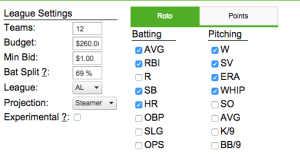 FanGraphs posted a fantasy auction calculator today, or maybe they posted it yesterday. I found it today.
FanGraphs posted a fantasy auction calculator today, or maybe they posted it yesterday. I found it today.
Enter your league parameters and it will give you dollar values for the players your league will be buying. That’s the promise.
One cool feature is you can bookmark the URL of your league and save the settings, so you don’t have to redo them over and over. The above link takes you to an old school 4×4 AL-only league.
Mike Trout shows up at $38, which is close, though a little low given that I allocated 69 percent of the budget for hitters.
The calculator uses a position adjustment factor, like the one at Last Player Picked, which I have written about before. Mays Copeland no longer maintains the Last Player Picked site, but the link above is to a Github dump of the code for the Player Rater. I don’t know if the FanGraphs tool uses that source, but it seems likely, since they link to Copeland’s explanation of how the Rater works.
I’m no fan of automated position adjustments, I don’t think there is any place for them in deep only-leagues that auction almost all the available players. Position scarcity is a rostering issue, not a player value adjustment. But the effect on these prices seems modest, so maybe it’s okay. Or maybe that’s why Trout is only $38.
If you’re going to allocate extra money for the budgets of the best catchers and shortstops, take it from the worst outfielders and first basemen, not the best.
 The bigger problem with the calculator is that Felix Hernandez shows up at $49. Greg Holland is $42. Eight AL pitchers get prices of $40 or more, which certainly isn’t right. Right?
The bigger problem with the calculator is that Felix Hernandez shows up at $49. Greg Holland is $42. Eight AL pitchers get prices of $40 or more, which certainly isn’t right. Right?
The problem with pitchers is that the calculator is undervaluing innings pitched. Using the standard mode, the rater has only 11 pitchers in its top 108 with more than 100 innings pitched.
The experimental mode, which devalues relief pitching, leads to 17 pitchers with 100+ innings in the pool. This is problematic, too.
Forcing each team via the parameters to take at least five starters fixes this somewhat, but raises the question whether it is better to force the system to give each team four starters, instead, or six? I don’t know the answer, and neither do you, which means that the numbers the calculator is generating have to be at least a little suspect.
And a check of the list with forced starters shows that only 29 pitchers are projected to throw more than 100 innings. Another 21 are considered starters, but have as little as 10 IP projected for them.
Is this the pool that should be bought in the auction? Is it the pool that will be bought? I don’t think so, in either case.
Note that this may be an issue with the way the Steamer projections are mixed with the FanGraphs playing time estimates. Is it Steamer’s fault that it has valuable projections for players FanGraphs doesn’t think will see that much playing time this year? The playing time estimates are likely to improve as the spring goes along, so some of this is growing pains. We know how good FanGraphs products are, eventually, but some of this is built into the product.
The fact is, however, that using projections for fantasy prices is always problematic. As a reality check on the projections, a price for a projection line has some value, but when it comes to actually pricing a player for your auction, knowing what the market is for the player is much more important than what your projection is worth.
That’s why I think the most important price list you can have is your Bid List. That’s the top prices you would pay for each player, all of which add up to the total amount that’s going to be spent in your auction.
Your projections should mark the midrange of possible outcomes for a player, from the chance they’ll get hurt the day after you buy your team to the chance that they’ll win the MVP to the chance that they will play all season and be awful. Mix that all together and you end up with your reasonable projection. What is the most likely, the most boring really, outcome.
Your bid prices are a second look at risk. Do you want to pay for the possibly injured Yu Darvish or Masahiro Tanaka? How much? Do you want to take a flyer on Kris Bryant, who could be huge, or a bust? How much? That’s your bid price, the number you’re comfortable calling out during your auction.
Bid prices are wagers, they represent your estimation of where you think the market is under or overestimating estimating the value each player. You want in on the cheap guys, and to avoid overpaying for those in demand. Your bid prices tell you where you stand, which makes it a lot easier not to get caught up in the moment.
I guess I’m saying that it’s cool that FanGraphs has a auction price calculator, even if it isn’t that useful just yet, but that’s okay. You know when the pricer really becomes useful? When the season starts, and you need to figure out if your players are doing better or worse than expected. Real data makes for real useful calculate prices.



You must be logged in to post a comment.